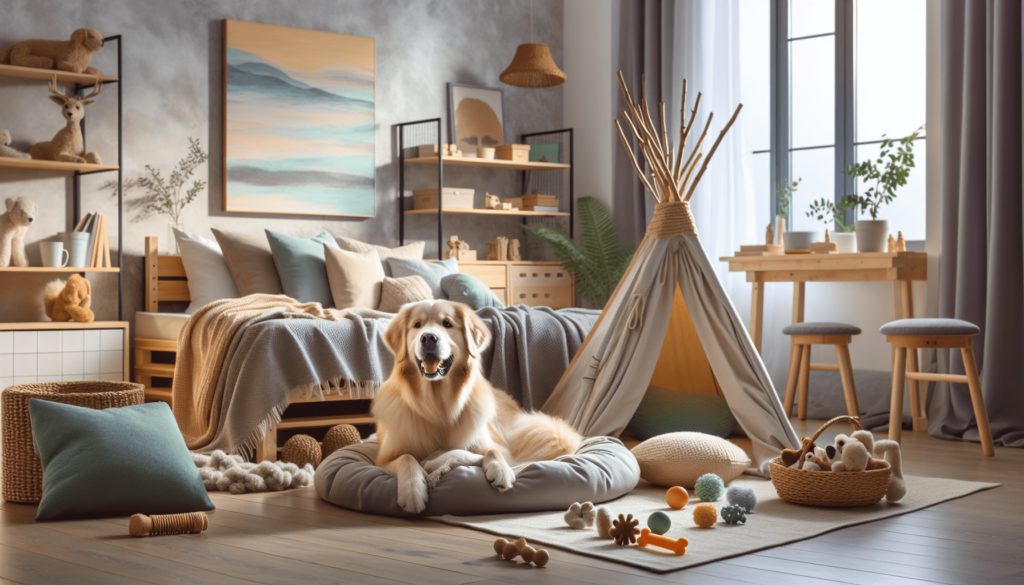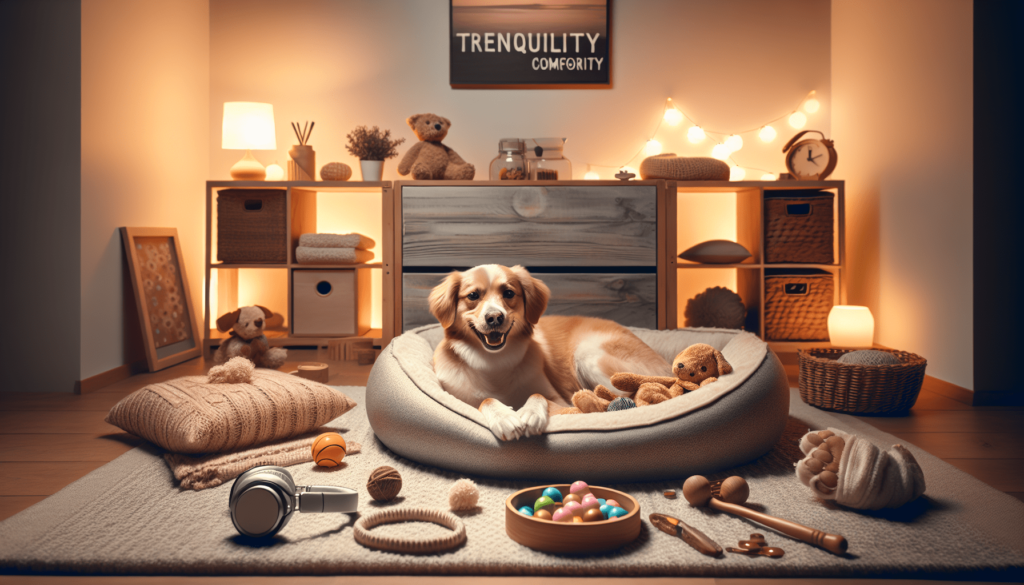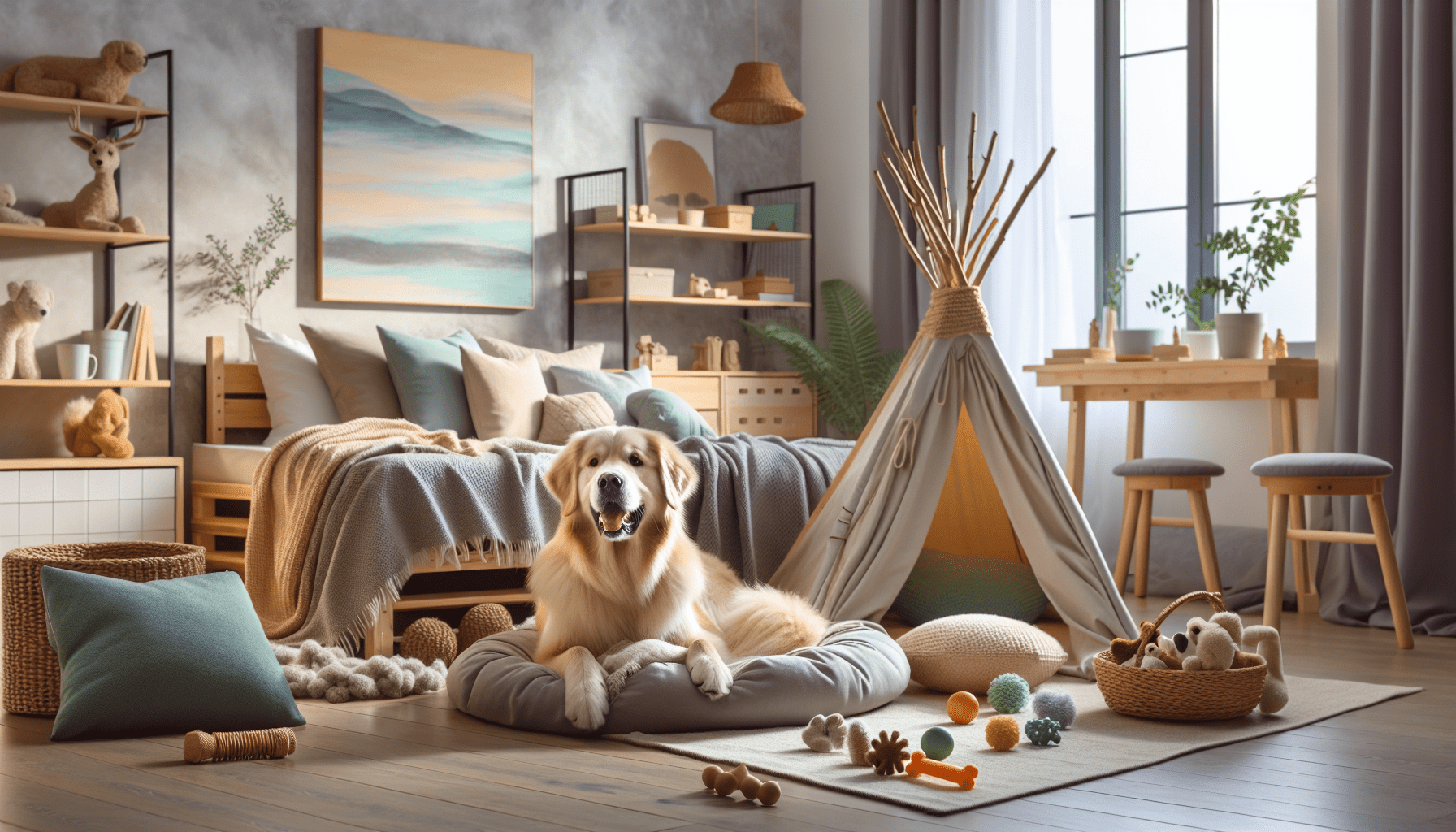Imagine coming home after a long, tiring day, all you want to do is plop down on your cozy sofa and unwind. Well, your canine companion deserves the same level of comfort and relaxation. Creating a comfortable spot for your furry friend is not only essential for their physical health, but it also contributes to their overall well-being. In this article, we will explore the significance of providing a comfortable spot for your dog to relax and discuss some effective ways to make their space as cozy as possible. So, grab a cup of tea, get ready to learn, and let’s dive into the world of canine comfort!
Creating a designated space for relaxation
Having a designated space for your dog to relax is essential for their overall well-being. Dogs, like humans, need a place where they can unwind and recharge. By creating a designated space for relaxation, you are showing your furry friend that you care about their comfort and happiness.
To create an ideal spot for your dog to relax, consider their preferences and habits. Some dogs might enjoy a cozy corner in the living room, while others might prefer a quiet room away from noise and distractions. Make sure the space is safe and free from any potential hazards, such as electrical cords or toxic plants.
You can enhance the relaxation area by offering comfortable bedding, such as a soft dog bed or a blanket. Provide your dog with a few toys or chew treats to keep them entertained and help them relax. Additionally, make sure the space is kept clean and well-maintained to create a peaceful and inviting atmosphere for your dog.

Ensuring physical comfort for your dog
Physical comfort plays a crucial role in your dog’s relaxation. Just like humans, dogs need a comfortable surface to rest their bodies and alleviate any aches or pains they may have. Investing in a high-quality dog bed or mattress can greatly improve your dog’s physical comfort and overall well-being.
When choosing a bed for your dog, consider their size, breed, and specific needs. Some dogs may require extra support for their joints, while others may prefer a plush and cozy bed. Pay attention to the materials used in the bed, ensuring they are hypoallergenic and easy to clean.
It’s also essential to keep your dog’s physical comfort in mind when selecting other elements for their relaxation area. Providing adequate warmth during colder months, such as using a heated bed or blanket, can make a significant difference in your dog’s comfort level. Similarly, ensuring proper ventilation during warmer months is important to prevent overheating.
Promoting mental relaxation
In addition to physical comfort, mental relaxation is equally important for your dog’s well-being. Dogs, just like humans, can experience stress and anxiety. Providing them with a dedicated space for mental relaxation can help them unwind and alleviate anxiety.
One way to promote mental relaxation is by incorporating aromatherapy. Certain scents, such as lavender or chamomile, have calming effects on dogs. You can introduce these scents in the form of natural candles, diffusers, or even dog-specific sprays. However, it’s important to ensure that the scents you choose are safe for dogs and not overwhelming.
Another effective way to promote mental relaxation is through the use of soothing sounds. Dogs have sensitive hearing and can find comfort in calming sounds like classical music or nature sounds. You can play these sounds in the background to create a peaceful environment for your dog to relax in.
Enhancing feelings of security
Creating a designated space for your dog to relax can also enhance their feelings of security. Dogs are territorial animals and having a designated area that belongs solely to them can provide a sense of ownership and security. This is especially important for rescue dogs or dogs with a history of trauma or abandonment.
When designing the relaxation area, consider including elements that make your dog feel safe and secure. This can include a crate or a cozy den-like space where they can retreat to when they need some alone time. Ensure that the area is quiet and away from any potential stress-inducing stimuli, such as loud noises or excessive foot traffic.
It’s also important to establish boundaries and respect your dog’s need for personal space. Encourage family members or visitors to your home to give your dog space when they are in their designated relaxation area. This will help your dog feel secure and reinforce the idea that this is their personal retreat.
Improving overall well-being
Providing your dog with a comfortable spot to relax has numerous benefits that contribute to their overall well-being. When dogs have a designated space to unwind, they are more likely to experience better sleep quality, reduced stress levels, and improved overall health.
Just like humans, dogs need quality rest to maintain their physical and mental health. A comfortable relaxation area helps facilitate better sleep by providing a quiet and secure environment. When dogs have a good resting place, they are more likely to get the restorative sleep they need to maintain their energy levels and overall vitality.
In addition to better sleep, a designated relaxation area can also help reduce stress levels in dogs. By giving them a safe and comfortable space, you are providing them with a predictable and calming environment. This sense of security can help alleviate anxiety and promote a sense of well-being in your canine companion.

Preventing behavioral issues
A designated relaxation area for your dog can also help prevent behavioral issues. Dogs, especially those lacking mental and physical stimulation, may develop destructive behaviors or exhibit signs of anxiety or aggression. Providing a comfortable spot for them to relax can serve as a proactive measure to prevent these issues from emerging.
When dogs have a space where they can feel calm and secure, they are less likely to engage in destructive behaviors like excessive chewing or digging. Having their own relaxation area can offer them an outlet for relaxation and decrease their need to find stimulation elsewhere.
Furthermore, a designated relaxation area can help prevent separation anxiety in dogs. When you are not at home, your dog can retreat to their designated area, which provides them with a sense of security and reduces the chances of them experiencing separation-related distress. This can contribute to a healthier and more balanced emotional state in your dog.
Fostering positive associations
By creating a designated space for relaxation, you also have the opportunity to foster positive associations in your dog. Associating the relaxation area with positive experiences can help your dog feel more inclined to use and enjoy the space.
To create positive associations, consider rewarding your dog with treats or praise when they choose to relax in their designated area. Use positive reinforcement techniques, such as clicker training or verbal cues, to encourage them to use the space willingly. Over time, your dog will come to associate the relaxation area with feelings of comfort and happiness.
It’s important to establish a routine around your dog’s relaxation time to further solidify these positive associations. Consistency in timing and cues can help your dog understand when it’s their dedicated relaxation time and reinforce the idea that this is their own special place.
Supporting recovery from illness or injury
A designated relaxation area for your dog can be particularly beneficial when they are recovering from illness or injury. Just like humans, dogs need a quiet and comfortable space to recover and heal. Offering them a dedicated area for rest can aid in their recovery process.
When dogs are recovering from illness or injury, they may experience pain or discomfort. Having a cozy bed or mat in their relaxation area can provide them with the necessary comfort and support they need to heal. Additionally, keeping the area calm and free from any potential stressors can contribute to their overall recovery.
It’s also important to consider any specific requirements your dog may have during their recovery period. For example, some dogs may need to wear a cone or bandages, and the relaxation area should accommodate these needs. Ensure that the space is easily accessible and that your dog has everything they need within reach.
Strengthening the bond between you and your dog
Creating a designated space for your dog to relax can also strengthen the bond between you and your furry friend. By providing them with a comfortable and safe environment, you are showing them that you prioritize their well-being and happiness. This can contribute to a stronger sense of trust and connection between you and your dog.
By spending time with your dog in their relaxation area, you can further solidify the bond between you. Engage in activities such as petting, grooming, or simply sitting quietly together. This quality time will not only help your dog relax but also deepen the emotional bond you share.
Engaging in training exercises or playing interactive games in the relaxation area can also be a fun way to strengthen your bond. This will help your dog associate the space with positive experiences and reinforce the idea that it’s a place where they can feel loved, supported, and safe.
Considering environmental factors
When creating a designated relaxation area for your dog, it’s important to consider the environmental factors that can affect their comfort and relaxation. Factors such as temperature, lighting, and noise levels can significantly impact your dog’s overall well-being and ability to relax.
Ensure that the temperature of the relaxation area is comfortable for your dog. During colder months, consider providing additional warmth through heating pads or blankets. In hotter weather, make sure there is adequate ventilation and access to water to prevent overheating.
The lighting in the relaxation area should be soothing and not too harsh. Consider using soft, warm lighting or natural light during the day to create a calming atmosphere. Avoid excessive bright lights or flickering sources that can be overwhelming or distracting for your dog.
Noise levels should also be taken into consideration. Keep the relaxation area away from noisy appliances or areas with loud music or television. Minimize any external noise that can cause your dog to become anxious or stressed.
By considering these environmental factors, you can create a space that truly supports your dog’s relaxation and well-being.
In conclusion, providing a designated space for your dog to relax is crucial for their overall well-being. By ensuring physical comfort, promoting mental relaxation, enhancing feelings of security, improving overall well-being, and preventing behavioral issues, you are giving your furry friend the gift of a peaceful and comfortable retreat. Additionally, creating a designated relaxation area can support recovery from illness or injury, foster positive associations, strengthen the bond between you and your dog, and positively impact environmental factors. Remember to tailor the space to your dog’s preferences and needs, and consistently reinforce the idea that this area is their special place. Your dog will thank you for it with wagging tails and a deep sense of contentment.

